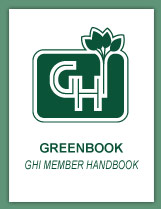GHI & Greenbelt History
The housing cooperative now called Greenbelt Homes, Inc. (GHI) was incorporated in 1952. But the history of its homes began fifteen years earlier, when in 1937, the United States built the first government planned community and named it Greenbelt.
The federal government started this project during the Great Depression because it wanted to provide much needed affordable housing and it wanted to create jobs. Greenbelt was one of
 |
three New Deal "Green Towns" modeled after the English garden cities of the nineteenth century. Government planners called the town "Greenbelt" because of the surrounding belt of green forestland. Greenbelt's plan featured inner walkways, underpasses, playgrounds, schools, businesses, and facilities for recreation. Most of the 885 original homes were row houses and apartments that were grouped into superblocks which separated pedestrians from road traffic. The town center now called "Roosevelt Center" was one of the first mall-type shopping centers in the United States.
In 1941 the government built another 1,000 row houses to house the increasing number of federal workers in Washington, D.C. Since most of the workers were employed in the war effort for World War II, the homes were referred to as "Defense Homes."
Greenbelt residents formed a housing cooperative to purchase most of the homes and much of the woodland in 1952 when the U.S. Congress voted to sell off the Green Towns. The cooperative, which was originally called Greenbelt Veterans Housing Corporation, later became known as Greenbelt Homes, Inc.
Greenbelt was founded by the federal government as a whites-only community, with other membership criteria relating to family type, religion, and income. But today, Greenbelt Homes, Inc. is a community that welcomes and values diversity and inclusivity.
For more on Greenbelt's unique place in the history of American culture, visit the following website resources:
- The Greenbelt Museum, with lectures, exhibits, and an actual historic house furnished with objects from the 1930s
For articles written at the time about the New Deal development and the founding of the cooperative visit:
- Time Magazine, "The Presidency: Homework," Nov. 23, 1936
- Time Magazine, "Housing: Greenbelt," Sept. 13, 1937
- Time Magazine, "The Administration: The Greenbelt Mystery," May 10, 1954
To read about another Green Town, Greendale, Wisconsin:
- Milwaukee Journal Sentinal, "Homes with a History," August, 20, 2008
- Milwaukee Journal Sentinal, "An American Original," August 20, 2008




